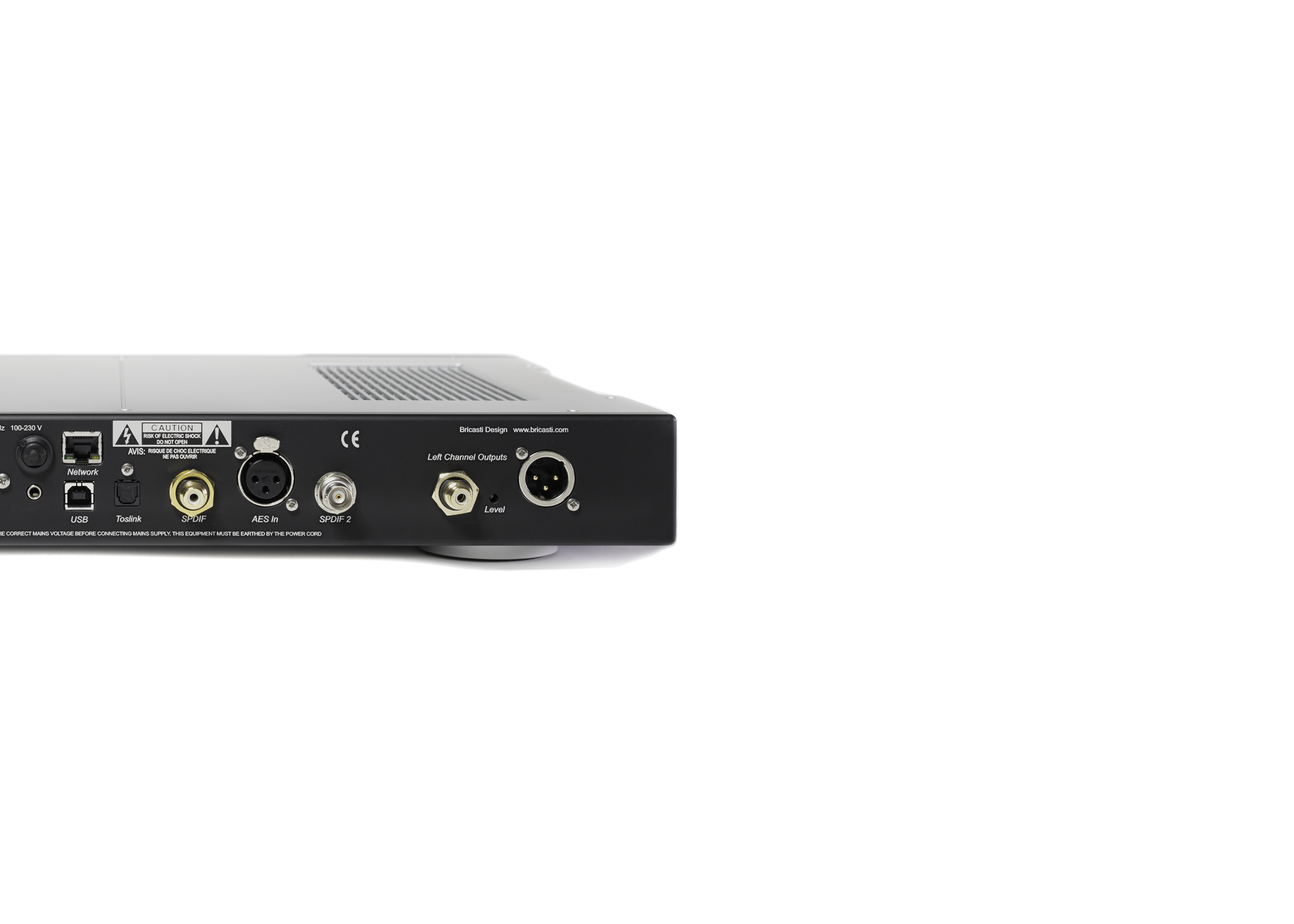
M11 CLASSIC R-2R, A DAC FOR MUSIC LOVERS
BRICASTI DESIGN - HISTORY - REVIEWS - TECHNOLOGIES - PRODUCTS - CLASSIC SERIES - SOURCES - PREAMPLIFIERS - AMPLIFIERS - PLATINUM SERIES
Bricasti Design M11 R-2R Classic DAC
Review by Jason Kennedy, THE EAR
When Madrigal Labs folded in 2004 and the Mark Levinson brand they worked for was sold to Harman, Brian Zolner and Casey Dowdell combined their names with a little bit of Italian flare to create Bricasti Design. These guys are audio engineers to the core, not the sort of people to use old digital to analogue conversion techniques for reasons of nostalgia. So why did they choose to create an R2R ladder DAC in the shape of the M11 Classic?
R2R ladder DACs are old hat, they were superseded by delta/sigma converters because the original ladder DACs were good for 14-bits at best whereas modern D/S converter chips can run at up to 32-bits without breaking a sweat. They won the spec war hands down and that’s why they are found in the vast majority of digital components today. The reason for ladder or R2R DACs being limited in the past was the degree of precision required to make high bit rate examples was not available, this however has been changing and the discrete converter inside the Bricasti M11 Classic is good for up to 20 bits.
Apparently Bricasti took an industrial ladder DAC, in essence one that was not made for audio, and built it into an environment that meant it could be used for this purpose. A job that was apparently challenging to say the least but presumably audio engineers like this sort of challenge. The fact they have been able to achieve 20-bit resolution with it is a testament to their success.
I have long been a fan of ladder DACs because they time better than the delta/sigma alternative and have a greater sense of musical engagement as a result. The reason why vinyl sounds better than digital 99% of the time is timing, there is no processing involved in the analogue signal that comes of a record whereas digital systems always require a degree of processing and D/S more than most. They might measure well, but like many amplifiers, measurements only get you so far, actual sound quality does not necessarily follow suit.
The M11 Classic is Bricasti’s least expensive R2R DAC, yet it contains the core elements of the R2R DAC in the company’s flagship M21 converter. The M21 contains three separate DACs, one dedicated to delta/sigma, one for DSD and an R2R ladder DAC, users can select between these options to get the sound that works best for their systems and tastes. For those of us that prefer the ladder DAC sound the M11 Classic, priced at half what is asked for the M21, this is a bit of a bargain. It has the same broad array of inputs including the option for a LAN network connection, this is quite a rarity and means that you only need an ethernet connection to your network in order to be able to stream music. Buyers can also specifiy an I2S connection for Bricasti’s M19 SACD/CD transport.
The USB input allows for the highest bit rates but LAN is good for up to 384kHz and DSD128. Analogue outputs are of the usual single ended and balanced varieties with good quality connectors on all the socketry, the only feature that is not offered is a clock link, this probably because Bricasti go to great lengths to offer superior onboard clocking, something that is more critical in ladder DACs than the alternatives according to Brian Zolner.

The M11 Classic is a slim unit built in the Bricasti style that owes a lot to their Madrigal Labs origins, with black and silver anodised aluminium, a small array of switches and a rotary controller. The latter is used to select between inputs, filters etc and as a volume control when the DAC is connected directly to a power amp, Bricasti supply a remote control with the finished M11 Classic but I had a pre-production prototype without this luxury.
There are four filter options on the M11 Classic, two linear phase and two minimum phase, the characteristics of each are shown in the user manual and the differences are small, for instance filter 0 has a passband of 20kHz and stopband attenuation of 111dB, filter 1 is 19.5kHz and 103dB. Yet differences are audible and having established that I prefer minimum phase filters with the Bricasti M1S2 a year ago I started with filter 0 and moved onto filter 1 which is subtly different in a good way.
Sound quality
In the first instance I hooked the M11 Classic up to my Lumin U2 mini streamer with a Network Acoustics muon2 USB cable and used its RCA outputs to connect the DAC to the Townshend Allegri Reference preamp using Atlas Arran Ultra cables. The result was distinctly supple, that is it was very articulate and revealing while at the same time having a strong sense of engagement thanks to very good timing. It delivers the power of the music without bludgeoning you, instead dynamics are faithfully rendered with plenty of contrast but no hard, digital edges, just the natural leading edges of the notes. Double bass sounds superb with weight and tactile presence not to mention speed, there is a sense of very quiet backgrounds and precision without edginess, just clean yet fluent sound that is hard to put down.
The better the recording the better the result as you might hope, Anouar Brahem’s Astounding Eyes of Rita on ECM is just such a production and the M11 Classic lets you know all about it with an expansive soundstage filled with beautiful acoustic sounds, it feels like you could walk into the space where the music was capture. At this point I received an early sample of Network Acoustics latest AES/EBU digital cable and had to give it a go. Previous experiments with this connection have provided a better sense of musical flow at the expense of detail, but I was told that this one was different. This proved to be the case with a result that managed to combine these key qualities and deliver great timing, precise imaging and very natural tonal balance, it allowed the Bricasti to provide a well-focussed sound that had real drive and engagement with the Keith Jarrett Trio’s version of Straight No Chaser (The Old Country – More from the Deer Head Inn, ECM). This was so distracting that the pianist’s warblings ceased to be an issue and I was carried away by the playing from a trio at the height of its powers. Of particular note is the way that the applause at the end of the piece defined the space so well, it really brought across the intimacy of the performance and how that connection allowed the musicians to express themselves so well.

The M11 Classic doesn’t appear to have any tonal characteristics of its own and makes alternatives sound as if they do by comparison, it is genuinely neutral which means that you hear what the artist intended rather than a subtly tweaked version which might sound great with some albums but will get in the way with others. Every audio component is voiced to some extent, the engineers make choices about components in output stages for instance and these have a bearing on the balance, but the choices made in this DAC have clearly been made in the name of maximum transparency and minimal intrusion. Nothing added, very little taken away.
I particularly like the roundness of the notes it produces, the attack, the tonal colour and the decay combine to deliver sounds that have shape and position within the flow of notes, each as distinct as the producer intended and coherent with whatever else is going on. This allows music played on the M11 Classic to speak to the listener, or to put it another way, for the listener to understand what the performer is trying to communicate, which after all is what music is all about. It’s relatively easy to achieve with simpler musical forms but the more complex the material the better the system has to be to deliver that message in a way that we can comprehend and appreciate. You can play banging tunes on this Bricasti and they will sound boombastic but you can also play denser material that might otherwise be avoided, so called ‘difficult’ jazz or classical makes more sense with the M11 Classic. In this respect it does what all good high fidelity equipment should, it opens the user up to a wider array of music to enjoy and appreciate.
Vocals are handled exceptionally well thanks to its communication skills, our ears are attuned to the human voice and we are very sensitive to changes here, so when you get a genuinely transparent, uncoloured converter like this, voices are revealed in their full glory. I found this with a range of artists from Van Morrison through Joni Mitchell to Tamara Lindeman of The Weather Station and Sami singer Mari Boine. Each bringing a distinct character to the table which the M11 Classic gives full rein.
I also tried the optional network card that turns the M11 Classic into a streamer when hooked up to the network over ethernet, you select the Bricasti as a player in the control app of your choice, select LAN on the front panel and press play. With this connection it delivered a more relaxed and easeful sound than USB with a character that will appeal to anyone who finds digital hard and grainy. In fact I would imagine that this input will appeal to an awful lot of folks whose systems can err toward the forward or bright when used with digital sources. If you don’t already have a streamer/network bridge then this option should be considered essential.
Toward the end of the review period an Xact S1 Evo server/streamer arrived for assessment and made me reappraise the Bricasti’s USB performance on account of that being the Xact’s only output. Simply put I was blown away by this pairing, the Xact is clearly extremely good but this wouldn’t have been so abundantly obvious without a DAC that could reveal as much. I suspect that the M11 Classic is unlikely to hold any digital source back.
Conclusion
I could quite happily live with the Bricasti Designs M11 Classic, I have always enjoyed the coherence that ladder DACs bring to the digital table and this one manages to do so alongside impressive clarity and depth of detail. The high build quality and breadth of inputs is also very attractive, like all Bricasti products it feels like it is built to last and has been created by people who are in it for something other than the money.








